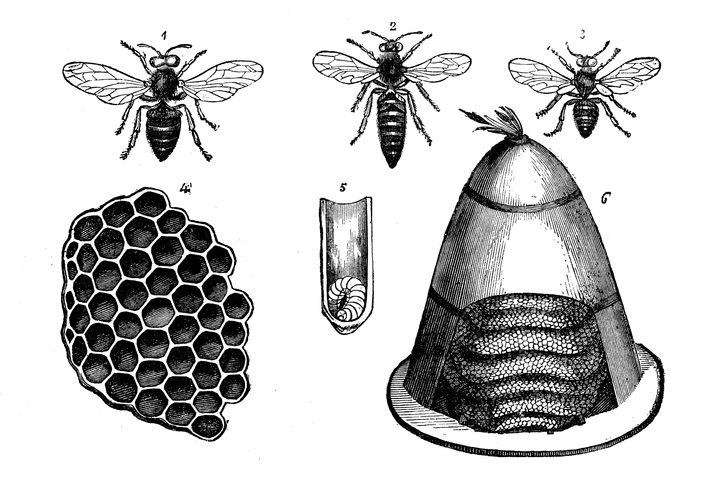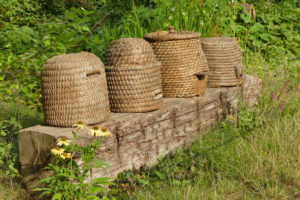- All-In-One Beekeeping for the Bees
- +1-608-728-8233
- info@beepods.com
Three Key Lessons We’ve Learned From Past Beekeepers

Beekeeping is a 9,000-year old profession that has seen many changes over the years. While some changes happened much more recently than 9,000 years ago, those changes have allowed beekeeping to become what it is today. At Beepods, we believe in Beekeeping For The Bees and we are delighted to see that the lessons we’ve learned from our past have made the lives of bees better.
Building a Hive and Harvesting Honey
Hives and honey go hand-in-hand and not for the obvious reasons. Ancient beekeepers, like those in Greece, Egypt, Africa, Europe, and South America, all constructed hives that were extremely difficult to harvest honey from. The Egyptians built their beehives in horizontally stacked clay pots made from Nile River mud. In Ancient Greece and Europe, beekeepers made Skeps — upside-down clay pots or wicker baskets. In Africa and South America, hives were made out of hollow logs.
 While all of these hive designs seem like ideal habitats for honey bees, their shared flaw was that to harvest the honey, the beekeeper had to break open the hive. A broken hive means — you guessed it, a dead colony. Because honey was such a sweet treasure, beekeepers would do anything to harvest it. It wasn’t until the use of wooden box hives and bars that beekeepers were able to harvest honey without harming their colony.
While all of these hive designs seem like ideal habitats for honey bees, their shared flaw was that to harvest the honey, the beekeeper had to break open the hive. A broken hive means — you guessed it, a dead colony. Because honey was such a sweet treasure, beekeepers would do anything to harvest it. It wasn’t until the use of wooden box hives and bars that beekeepers were able to harvest honey without harming their colony.
During the early 1800s, Europeans began building box hives with removable bars. This led to the creation of the Langstroth hive in the 1850s by L.L. Langstroth. During the 1960s the Tanzania and Kenyan top-bar designs saw a rise in popularity. These are what the Beepods top-bar hive is modeled after. While the Langstroth hive is still popular, the reason we use the top-bar hive is that it makes it much easier to do inspections, remove bars, and keep your bees safe. Because you are only removing one bar at a time to harvest honey, your bees don’t feel as agitated. With calm bees, you don’t need to use tools such as a smoker to keep your bees calm. This makes it much safer to keep bees.
Providing Forage
You like to eat a variety of food, right? So do bees! Bees love collecting nectar and pollen from all sorts of sources. Bees that only live off one source of forage live in a monoculture. This can shorten their life span and decrease honey production. It’s a commonly known fact that bees are responsible for one in every three bites of food we take. Because food production across the globe is at an all-time high, farmers in the United States have been transporting hives across the country to help pollinate crops. While crops need pollination, this has left bees to live in monocultures. Plus, all of the stress of being picked up and moved is decreasing the lifespan of these honey bees.
 To solve this problem, farmers had to take a lesson from an ancient beekeeping civilization, the Egyptians. As mentioned above, the Ancient Egyptians used to build hives in stacked clay pots. They would keep these pots on barges and move them up and down the river to new and plentiful forage sources. To combat monoculture today, farmers are planting strips of wildflowers and other various forage sources around crops so that bees stay healthy. They are also looking to reduce how often if at all the bees need to travel.
To solve this problem, farmers had to take a lesson from an ancient beekeeping civilization, the Egyptians. As mentioned above, the Ancient Egyptians used to build hives in stacked clay pots. They would keep these pots on barges and move them up and down the river to new and plentiful forage sources. To combat monoculture today, farmers are planting strips of wildflowers and other various forage sources around crops so that bees stay healthy. They are also looking to reduce how often if at all the bees need to travel.
Final Thoughts
Bees are vital to our survival. They help grow the food we eat and the trees we need to breathe. Our relationship with bees has varied over the centuries and we have learned so much from past beekeepers that today, humans are building the foundations of an everlasting partnership with bees. It will be interesting to see what future beekeepers learn from us.
Monica Cull
Latest posts by Monica Cull (see all)
- How To Keep Your Bees Calm During An Inspection - June 30, 2021
- Pollinator Week: How COVID-19 And Modern Technology Have Impacted Bees - June 23, 2021
- Bee-Themed Activities You Can Do With Your Kids This Summer - June 17, 2021



